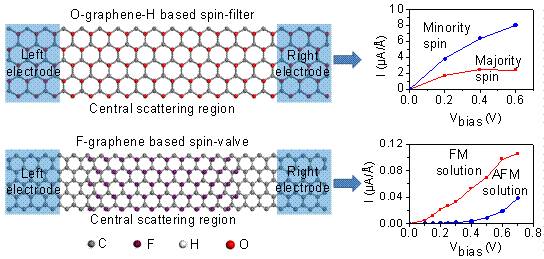Time:2011-04-08ClickTimes:
In terms of dimension, all materials can be classified into zero-dimensional, one-dimensional, two-dimensional, or three dimensional materials. The discovery of graphene in 2004 rendered us a real 2D material for the first time, triggered a deep research in this field, and won the Nobel Prize for Physics in 2010. Other than its high mobility, which can be utilized to prepare high-performance field effect transistor, graphene also has a long spin relaxation time and length, and this makes graphene a promising material in applications of spintronics. But the magnetoresistance (MR) of graphene-based spin-valves is quite small. By now the maximum MR observed is down to 10%. A marked feature of 2D materials is the exposure of two surfaces, which provide a freedom for structure tuning. Under the direction of Prof. Jing Lu and Prof. Zhengxiang Gao at School of Physics in Peking University, using first principle study of density functional theory, undergraduate student Linze Li and graduate student Rui Qin et al. found that, upon functionalization on one side or different functionalizations on two sides, the spintronic performance of graphene can be much enhanced. Graphene functionalized with O on one side and H on the other side (O-graphene-H) is found to be a ferromagnetic metal with a spin-filter efficiency up to 54% at the finite bias of 0.6 V. The ground state of graphene semi-functionalized with F (F-graphene) is an antiferromagnetic semiconductor with a bandgap of 1.17 eV, while its ferromagnetic state has a metallic nature. By controlling the external magnetic field, one can change the magnetic state of the structure and thus control the current. The resulting room-temperature MR is up to 2200%, which is one order of magnitude larger than the available experimental values. This work opens new avenues for application of graphene in spintronics devices, and the result of this work has been published online on ACS Nano. (http://pubs.acs.org/doi/abs/10.1021/nn102492g)

|
Schematic relaxed two-probe models of a O-graphene-H based spin-filter device and a F-graphene based spin-valve device. The minority spin current is obviously larger than the majority one in the spin-filter device; the current of FM solution is much larger than the current of AFM solution in the spin-valve device.
This work was supported by the NSFC (Grant Nos. 10774003, 90626223, and 20731162012), National 973 Projects (No. 2007CB936200, MOST of China), Program for New Century Excellent Talents in University of MOE of China, Fundamental Research Funds for the Central Universities, National Foundation for Fostering Talents of Basic Science (No. J0630
